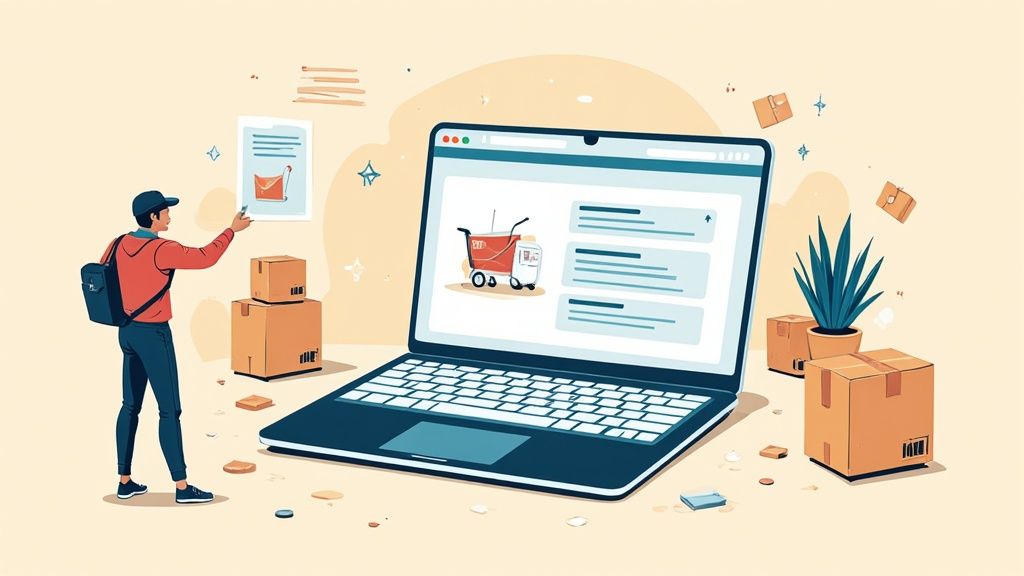Understanding Today’s Dropshipping Landscape
Dropshipping has grown into a $221.3 billion industry in 2022, making it an attractive business model for those starting their entrepreneurial journey. While the low startup costs and location flexibility appeal to many newcomers, it’s essential to separate myths from facts. Like any business venture, dropshipping comes with both opportunities and real challenges that need careful consideration.
Navigating the Competitive Landscape
The dropshipping market is expected to reach $931.9 billion by 2030, growing at 22.8% annually. However, this promising outlook comes with intense competition. It’s similar to opening a restaurant – having a kitchen isn’t enough; you need the right menu, ambiance, and service to stand out. Success in dropshipping requires finding your unique market position, selecting the right products, and developing a brand that connects with your customers.
The Reality of Dropshipping Success Rates
Here’s a sobering fact: only 10% to 20% of dropshipping businesses succeed. This isn’t meant to discourage you but to emphasize the need for preparation and persistence. Think of successful dropshippers as skilled surfers – they didn’t catch the perfect wave on their first try. Many tried, failed, learned from their mistakes, and kept going until they found their rhythm.
Building a Sustainable Business Model
Understanding profit margins is fundamental to dropshipping success. Most businesses see margins between 10% and 25%. For instance, selling higher-priced items might offer better profits but also brings stronger competition. It’s like running a restaurant – you need to price your menu high enough to make money but low enough to keep customers coming back. Your pricing strategy needs to balance profitability with market competitiveness.
The Power of Supplier Relationships
Strong supplier partnerships often make the difference between success and failure – 84% of online sellers confirm this. Your suppliers are like your business partners, not just vendors. When this relationship works well, you get reliable shipping, consistent quality, and smooth returns handling. This directly affects your customers’ satisfaction and your store’s reputation. Interestingly, suppliers also benefit, earning 18.33% more profit compared to direct sales. By working together as partners rather than just transaction-based contacts, both sides can build lasting success. Regular communication and mutual respect form the foundation of these valuable partnerships.
Finding Your Perfect Product-Supplier Match
The success of any dropshipping business depends heavily on choosing the right products and suppliers who can deliver them reliably. Like picking quality ingredients for a recipe, selecting suppliers requires careful consideration beyond just finding the lowest price. Bad supplier choices based solely on cost can seriously damage your business. Let’s explore how to find the ideal product-supplier combination that will help your dropshipping venture thrive.
Evaluating Suppliers Beyond Price
While competitive pricing matters, it shouldn’t be your only criteria when choosing suppliers. Consider a scenario where you pick the cheapest supplier only to discover they take weeks to ship orders and frequently send defective products. This leads to angry customers and bad reviews that hurt your reputation. Smart dropshippers look at several key factors:
- Reliability and Communication: You need suppliers who consistently fulfill orders and keep you informed about inventory, delays, and issues. Clear communication helps you set proper customer expectations.
- Shipping Times and Methods: Quick delivery is crucial for customer satisfaction. Check what shipping options suppliers offer, typical delivery times, and tracking capabilities. More shipping choices can help reduce abandoned carts.
- Product Quality and Returns Handling: Even though you don’t handle products directly, maintaining quality standards is essential. Ask suppliers about their quality control process and return policies. Making returns easy and hassle-free builds customer trust.
Identifying Profitable Niche Products
Finding the right product niche is like finding a good fishing spot – you want an area with enough demand but not too many competitors fighting over the same customers. Good product research is key:
- Analyzing Market Trends: Keep track of what products are gaining popularity using tools like Google Trends and social media monitoring. For example, rising interest in sustainable products could signal a promising niche.
- Targeting Specific Customer Needs: Look for underserved customer segments within larger markets. Pet products, for instance, offer many opportunities to focus on specific breeds or pet care needs.
- Evaluating Competition: Study your competitors’ prices, marketing approaches, and customer feedback. This research reveals gaps where you can differentiate your business.
Building Lasting Supplier Relationships
Once you find good suppliers, focus on developing strong partnerships built on trust and open communication. Like a well-oiled machine, good supplier relationships help everything run smoothly:
- Regular Communication: Set up clear communication channels and stay in regular contact. This builds rapport and helps resolve issues quickly.
- Negotiating Favorable Terms: As your orders increase, work with suppliers on better pricing or priority processing. This shows your commitment while encouraging suppliers to value your business.
- Mutual Growth and Support: Treat suppliers as partners in your success. Share market insights and feedback to help both businesses grow. Research shows 84% of online sellers credit strong supplier relationships for their success, while suppliers see 18.33% higher profits when working with dropshippers.

By following these strategies, new dropshippers can turn supplier selection into a key advantage. This methodical approach creates a strong business foundation that helps you stand out in a competitive market. With your supplier partnerships in place, you’ll be ready to develop your roadmap for digital success, which we’ll cover next.
Creating Your Digital Success Blueprint
Once you’ve found reliable suppliers and winning products, it’s time to focus on marketing that brings customers to your store. This is about more than random social posts – you need a clear plan to turn interested shoppers into paying customers. Let’s explore how to understand your audience, create compelling content, and build an online store that works great on phones.
Understanding Your Target Audience
Think of your dropshipping store like a local business that knows exactly who their customers are. You need to get specific about who you’re trying to reach. What are their ages, interests, and problems they want to solve? For instance, if you sell eco-friendly pet supplies, you might focus on young pet owners who care about the environment. Having this clear picture helps you speak their language and show up where they spend time online.
Crafting Compelling Content and Building Community
Great content helps you connect with potential customers and keep them coming back. This could mean sharing useful blog posts about pet care tips, posting photos and videos that showcase your products, or featuring customer stories about their pets enjoying your items. It’s like building a neighborhood around your brand – when people feel part of something, they’re more likely to stick around and tell their friends. The key is creating content that helps and entertains, not just sells.
Leveraging Social Media for Dropshipping Success
Social media can make a huge difference for new dropshipping stores. The numbers show it – stores that use at least one social platform earn 32% more than those that don’t. Pick the platforms where your ideal customers hang out. If you’re targeting those eco-conscious pet owners, Instagram and Pinterest would be perfect for sharing beautiful product photos and your brand’s green values. Mix in helpful tips, fun contests, and real conversations with followers to build genuine relationships.
Optimizing for Mobile: The Dropshipping Essential
Here’s a fact that might surprise you – over 70% of people who visited online stores in 2023 did so on their phones. This means your store absolutely must work well on mobile devices. If your site loads slowly or is hard to use on a phone, shoppers will leave without buying. Make sure your website adjusts smoothly to different screen sizes and lets people check out easily on their phones. These small details can lead to many more sales.
Developing a Unique Brand Voice
Standing out in dropshipping means having a personality that people remember. Your brand voice is how you talk to customers across all your content. Look at how Innocent Drinks uses fun, playful language to make people smile. Finding your distinct voice helps shoppers connect with your store and choose you over others. When you’re consistent with your tone, people start to trust you more and come back to buy again. This builds the kind of lasting business we talked about earlier. Now that you have your digital plan mapped out, let’s look at the money side of running your dropshipping business in the next section.
Mastering the Numbers Game

Once you’ve set up your online store, it’s time to focus on the financial side of dropshipping – something many beginners overlook. Think of your numbers as your business compass – they tell you if you’re heading in the right direction and help you make smart choices along the way. Let’s explore how to price effectively, keep costs in check, and build a profitable business.
Pricing Strategies for Dropshipping Beginners
Getting your pricing right takes careful thought. You need prices that cover your costs and generate profit while staying competitive in the market. Here are three proven approaches:
- Cost-Plus Pricing: Start by adding up all costs (product, shipping, marketing) then add your target profit margin. For instance, with a $10 product cost, $5 shipping, and a 20% profit margin, you’d price at $18.75.
- Competitive Pricing: Check what similar sellers charge for comparable products. This gives you a market benchmark. You might price slightly below competitors to attract customers, or above them if you offer better service or faster shipping.
- Value-Based Pricing: Focus on what customers think your product is worth. If you’re solving a real problem or offering something unique, you can often charge more. This is how premium brands maintain higher prices while keeping customers happy.
Optimizing Your Operational Costs
Every dollar saved in operations is a dollar added to profit. Here’s how successful dropshippers keep costs down:
- Negotiate with Suppliers: As you sell more, ask suppliers for better rates. Volume discounts can really boost your margins, especially on popular items.
- Free Marketing Channels: Start with no-cost promotion through social media and content before spending on ads. This lets you test what works while building an organic following.
- Email Marketing: Build a mailing list to share deals and keep customers coming back. Email remains one of the most cost-effective ways to drive repeat sales and build customer loyalty.
Increasing Average Order Value
Small bumps in order size add up to big revenue gains over time. Try these proven techniques:
- Product Bundles: Package related items together at a slight discount. If you sell phone cases, create bundles with screen protectors or charging cables.
- Upsells and Cross-sells: Show customers related items they might need. When someone buys a camera, suggest memory cards or cleaning supplies.
- Free Shipping Thresholds: Set a minimum order amount for free shipping. This often encourages customers to add one more item to reach the threshold.
Understanding these financial fundamentals gives you much better control over your business health and growth potential. By staying focused on smart pricing, careful cost management, and strategic ways to increase order size, you build a stronger foundation for lasting success. Up next, we’ll look at common mistakes that can sink a dropshipping store – and how to avoid them.
Avoiding the Silent Store Killers

Running a successful dropshipping store requires more than just understanding finances – you need to spot and fix issues before they derail your business. These hidden problems can quietly damage your store over time if left unchecked. Let’s explore the most common challenges new dropshippers face and practical ways to overcome them.
Inventory Management: Staying Ahead of the Curve
Keeping track of inventory is tricky when you don’t physically stock the products. You rely completely on your suppliers having items in stock, which can cause major headaches. Picture this: A customer orders your bestselling product, but your supplier ran out – now you have an upset customer and potential refund on your hands.
The smart move? Work with multiple suppliers for your key products. Just as investors spread risk across different stocks, having backup suppliers means you won’t get caught short if one runs dry. Set up regular check-ins with suppliers about stock levels and get automatic alerts when inventory runs low – this helps you stay one step ahead.
Customer Service Excellence: The Heart of Your Business
Great customer service makes or breaks an online store. If you’re slow to respond, give unhelpful answers, or make returns difficult, you’ll quickly lose customers. Bad experiences spread fast through reviews and word-of-mouth, putting the brakes on your growth.
The solution is simple but takes commitment. Get good help desk software to organize customer messages and track issues properly. Create template responses for common questions to save time while keeping quality consistent. Most importantly, add a personal touch to show customers you care about their experience. A little extra effort here can turn an unhappy buyer into a loyal fan.
Quality Control: Protecting Your Brand Reputation
Even though you never touch the products, customers blame you if something arrives broken or poorly made. Bad quality leads to bad reviews and returns, which hurts trust and future sales. This hits new store owners especially hard as they build their reputation.
Take control by working only with suppliers who take quality seriously. Order samples yourself to check product quality before selling anything. Keep tabs on customer feedback about quality – it tells you quickly if a supplier starts slipping. These simple steps help catch problems early.
Shipping Challenges: Delivering on Promises
Many new dropshippers struggle with shipping. Whether it’s long wait times, surprise delays, or high costs, shipping problems can drive customers away fast. Modern shoppers expect quick, affordable delivery – fall short and they’ll shop elsewhere.
Be upfront about shipping from the start. Show clear delivery estimates on product pages and at checkout so customers know what to expect. Look for shipping options that balance speed and cost for your target market. Consider offering free shipping above a certain order value – it often encourages bigger purchases and makes customers happier.
By actively managing these common issues, you’ll build a stronger dropshipping business that stands the test of time. Focus on consistency and getting the details right – it pays off in steady growth and happy, returning customers.
Scaling Your Store With Confidence

Getting your dropshipping store off the ground is a big win, but it’s just the beginning. The real challenge lies in growing your business sustainably while maintaining quality and profitability. Let’s explore practical ways to scale your store with confidence, focusing on proven strategies that work for both new and established sellers.
Automating For Efficiency
As orders increase, doing everything manually becomes impossible. Tasks like processing orders, responding to customers, and tracking inventory can quickly overwhelm you. The solution? Smart automation. For instance, you can use order fulfillment software that connects your store directly to suppliers and handles the entire process automatically. This frees up your time to focus on growth. Similarly, setting up automated email responses for common customer questions helps maintain good service without burning yourself out.
Expanding Your Product Line Strategically
Adding new products is essential for growth, but it needs careful thought. Instead of randomly adding items, look at what your customers already buy and love. Think of it like a restaurant menu – each new dish should complement what you already serve and appeal to your regular customers. Study your sales data to spot trends and opportunities. When you find products that fit naturally with your current offerings, you’re more likely to succeed with the expansion.
Entering New Markets With Purpose
Breaking into new markets can boost your sales significantly, but it takes more than just copying what worked before. Each market has its quirks and preferences. You need to understand how people shop, what payment methods they prefer, and what rules you need to follow. It’s like being a chef who adjusts recipes for different tastes – what works in one place might need tweaking in another. Take time to understand your new customers and adapt your approach accordingly.
Managing Increased Complexity
As your business grows, keeping track of everything becomes more challenging. You’ll need better systems to stay organized and efficient. This might mean investing in inventory management software, using a customer relationship management (CRM) system, or hiring help for specific tasks. Think of it like upgrading from a small boat to a larger vessel – you need better equipment and a bigger crew to handle the increased demands.
To help manage this growth effectively, consider working with established eCommerce experts like eStore Factory. Their experience in optimizing product listings, managing ads, and handling Amazon accounts can make scaling your business smoother and more successful.

